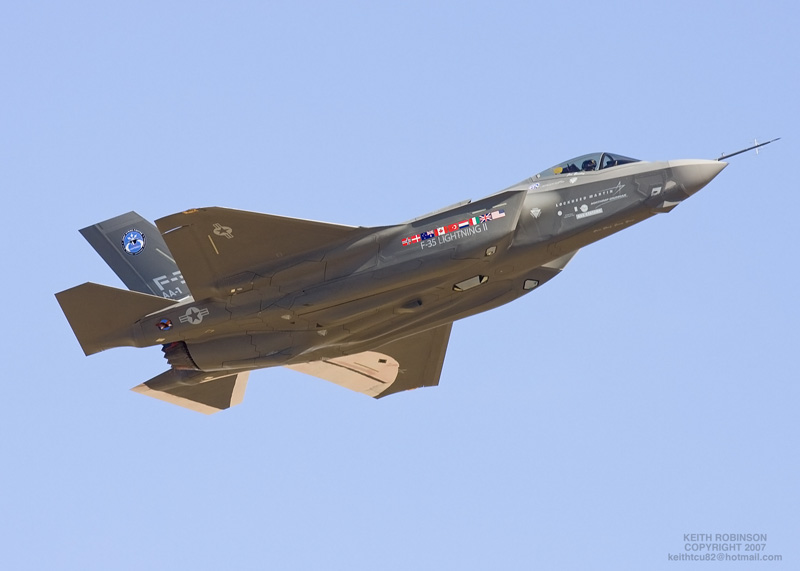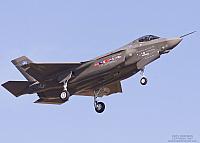Fighter Jet News
F-35 Lightning II News
F-35 JSF flies again
December 7, 2007 (by
Eric L. Palmer) -
The F-35 Joint Strike Fighter returned to flight today after being grounded since May due to technical difficulties.

The Lightning II's flight began at 1:30 p.m. CST when Chief Test Pilot Jon Beesley executed a military-power (full power without afterburner) takeoff, ran the engine at various power settings and checked flying qualities at 6,000, 17,500 and 20,000 feet, and performed a fuel-dump test at 250 knots. Landing was at 2:15 p.m. CST. Beesley reported that the tests were successful and the jet was a pleasure to fly.
"The Lightning II embodies a long list of advancements that will make it better, smarter and more reliable than anything that’s come before it, and those technologies are extraordinarily mature in this first-ever F-35," Beesley said. "When you project ahead to the F-35s that will be entering the fleet in 2010, you see fighters that benefit from the testing we're doing now – fighters that will set new standards for combat-readiness right out of the box."
At 3:30 p.m. CST, the Cooperative Avionics Test Bed – "CATBird" – took off on a two-hour functional check flight, one of its final sorties before aerial F-35 mission systems testing begins. CATBird is a highly modified 737 airliner designed to test, integrate and validate the full F-35 mission systems suite in a dynamic, airborne environment before the system ever flies in an F-35 aircraft.
CATBird flights with the CNI system operating will be the first in a series of airborne tests that will methodically add constituent elements of the F-35 mission systems suite until the entire Lightning II avionics package is onboard the CATBird. The mission systems will be fully integrated and operating as they would on an F-35 aircraft – a first for a fighter test program.
"The F-35 will have the most powerful and comprehensive avionics ever flown on a fighter aircraft, and it represents a phenomenal capability," said Doug Pearson, Lockheed Martin vice president of the F-35 Integrated Test Force. "Our goal is to get the system perfected on the CATBird so that it works exactly as advertised when we put it in the Lightning II fighter."
December 18th should mark the roll-out of the F-35B, the Short Take-off and Vertical Landing (STOVL) variant of the F-35 Joint Strike Fighter.
The technical difficulties that grounded the first F-35 test aircraft back in May of 2007 were the result of an electrical failure in flight. Some months later there were engine problems in ground testing. After the F-35 electrical system was redesigned and fixed along with setting up new software there was period of several weeks while the engine problems were sorted out and numerous ground tests performed to make sure the aircraft was safe to fly.
The F-35 program has now completed it's 20th test flight.

The F-35 returns to flight this afternoon at NAS Fort Worth, Lockheed-Martin facility on December 7th, 2007. [Photo by Keith Robinson]
"The Lightning II embodies a long list of advancements that will make it better, smarter and more reliable than anything that’s come before it, and those technologies are extraordinarily mature in this first-ever F-35," Beesley said. "When you project ahead to the F-35s that will be entering the fleet in 2010, you see fighters that benefit from the testing we're doing now – fighters that will set new standards for combat-readiness right out of the box."
At 3:30 p.m. CST, the Cooperative Avionics Test Bed – "CATBird" – took off on a two-hour functional check flight, one of its final sorties before aerial F-35 mission systems testing begins. CATBird is a highly modified 737 airliner designed to test, integrate and validate the full F-35 mission systems suite in a dynamic, airborne environment before the system ever flies in an F-35 aircraft.
CATBird flights with the CNI system operating will be the first in a series of airborne tests that will methodically add constituent elements of the F-35 mission systems suite until the entire Lightning II avionics package is onboard the CATBird. The mission systems will be fully integrated and operating as they would on an F-35 aircraft – a first for a fighter test program.
"The F-35 will have the most powerful and comprehensive avionics ever flown on a fighter aircraft, and it represents a phenomenal capability," said Doug Pearson, Lockheed Martin vice president of the F-35 Integrated Test Force. "Our goal is to get the system perfected on the CATBird so that it works exactly as advertised when we put it in the Lightning II fighter."
December 18th should mark the roll-out of the F-35B, the Short Take-off and Vertical Landing (STOVL) variant of the F-35 Joint Strike Fighter.
The technical difficulties that grounded the first F-35 test aircraft back in May of 2007 were the result of an electrical failure in flight. Some months later there were engine problems in ground testing. After the F-35 electrical system was redesigned and fixed along with setting up new software there was period of several weeks while the engine problems were sorted out and numerous ground tests performed to make sure the aircraft was safe to fly.
The F-35 program has now completed it's 20th test flight.
Thanks to John Kent of Lockheed Martin for providing information for this report
Related articles:
Forum discussion:
Tags
- F-35B powered up for the first time ( 2007-10-26)
- Lockheed plans F-35 JSF flight test changes ( 2007-09-17)
- Dutch request participation in Joint Strike Fighter testing ( 2007-07-12)
- F-35 Lightning II news archive
Forum discussion:
- F-35 resumes flight testing - Flight 20 and onwards ( 50 replies)
Tags
Additional images:

F-35 on approach into NAS Fort Worth after completing its 20th flight on December 7th, 2007. [Photo by Keith Robinson]
